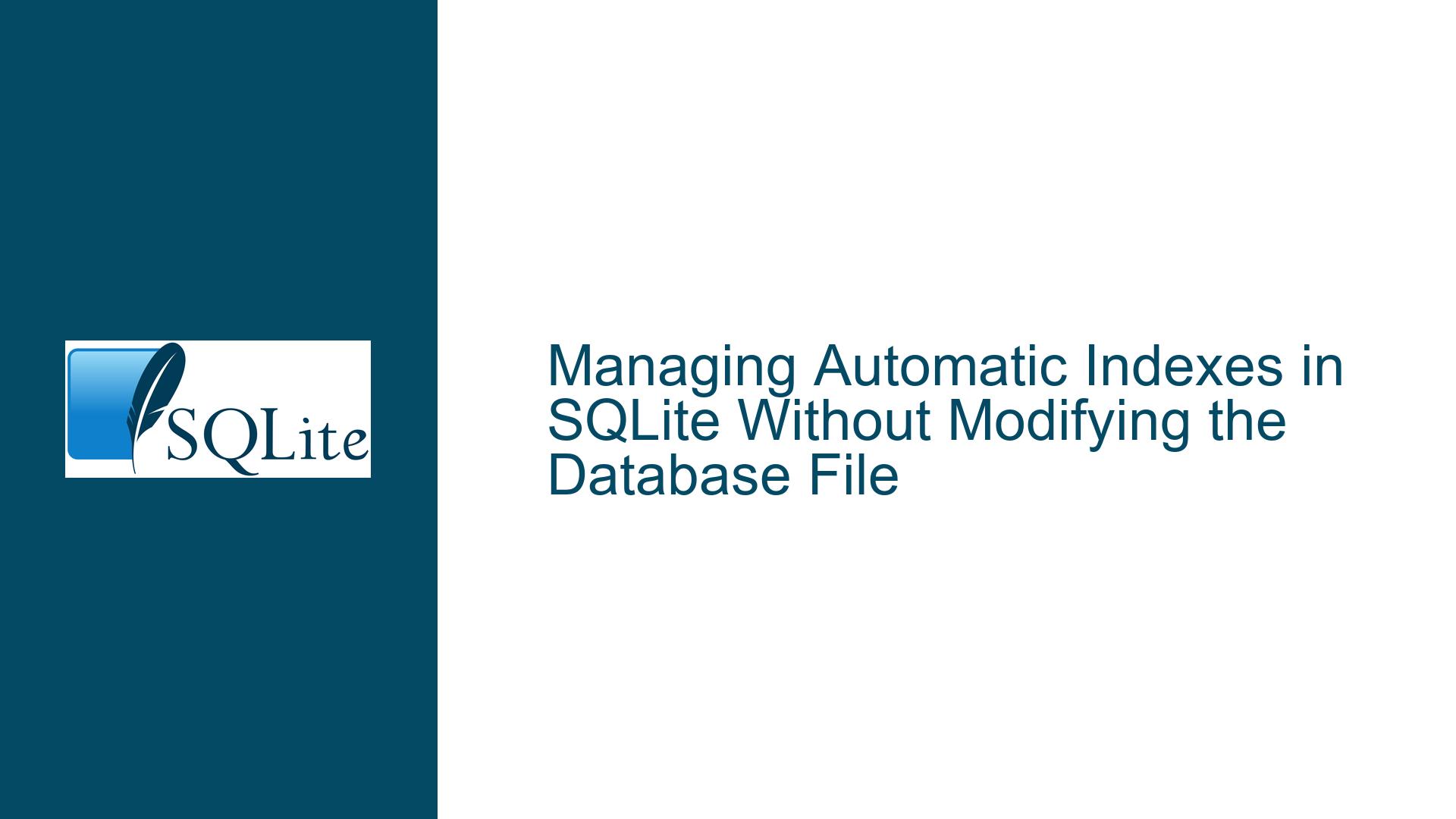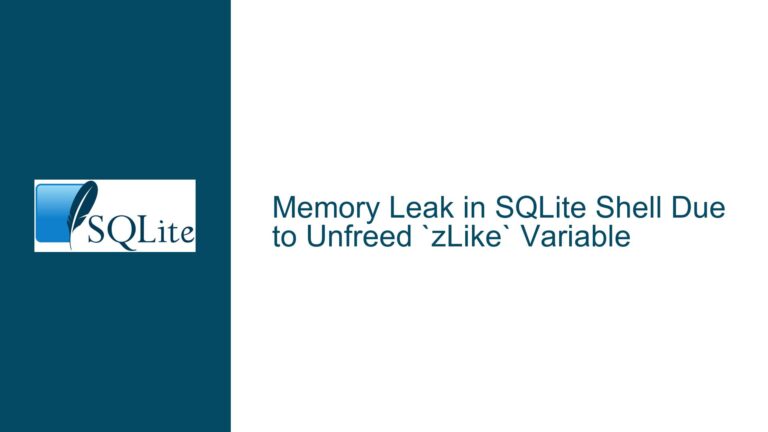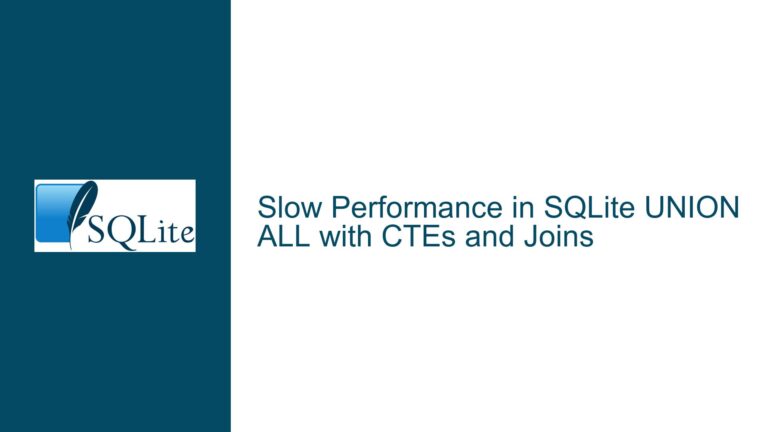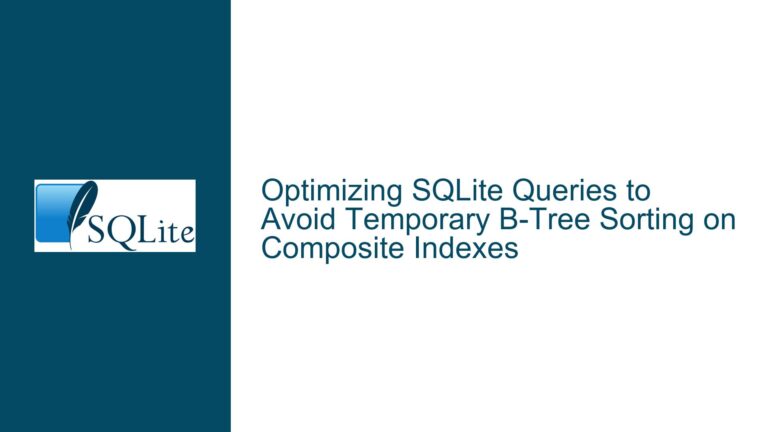Managing Automatic Indexes in SQLite Without Modifying the Database File
Automatic Index Creation Behavior and Its Impact on Read-Only Workflows
Issue Overview
SQLite’s query optimizer automatically creates transient indexes—referred to as "automatic indexes"—when executing queries that would benefit from an index but none exists on the targeted columns. These indexes are generated to improve query performance for JOIN operations, WHERE clauses, or ORDER BY clauses that lack suitable existing indexes. However, this behavior introduces challenges in scenarios where modifying the database file is undesirable, such as with read-only databases, environments prioritizing minimal I/O operations, or systems where file size inflation must be avoided.
Automatic indexes are transient by design and are not persisted to the database schema. Their creation and destruction occur within the scope of individual queries or transactions. When SQLITE_CONFIG_LOG is enabled, these operations are logged as entries like "automatic index on Table(Column)." The primary concerns raised involve three facets:
- Avoiding Database Modifications: Creating persistent indexes alters the database schema, which may conflict with read-only configurations or version-controlled schemas.
- Storage Location of Automatic Indexes: Whether automatic indexes reside in memory or spill to temporary files, and how their memory consumption is regulated.
- Controlling Automatic Index Creation: The effectiveness of the
SQLITE_OMIT_AUTOMATIC_INDEXcompile-time flag in disabling automatic index generation and potential misconfigurations in custom builds.
The interplay between SQLite’s automatic indexing logic and its temporary storage management is critical here. Automatic indexes are stored in SQLite’s temp space, which may reside in memory or on disk depending on configuration parameters like SQLITE_TEMP_STORE and the size of the data involved. By default, SQLite allows temporary storage to occupy up to SQLITE_DEFAULT_CACHE_SIZE (typically 2,000 pages) in memory before overflowing to disk. However, this behavior is nuanced and influenced by runtime settings such as the PRAGMA temp_store directive.
Root Causes of Unwanted Automatic Indexing and Storage Overhead
Possible Causes
Query Planner Heuristics Favoring Automatic Indexes
The SQLite query optimizer generates automatic indexes when it estimates that doing so will reduce query execution time. This decision is based on factors like table size, the selectivity of query conditions, and the absence of existing indexes. For large tables or complex joins, the optimizer may prioritize index creation even if the user intends to avoid schema changes.Temporary Storage Allocation Policies
Automatic indexes are stored in SQLite’s temp space, which is governed by thetemp_storepragma and compile-time settings. When the size of an automatic index exceeds the available memory (as defined bySQLITE_DEFAULT_CACHE_SIZEorPRAGMA cache_size), SQLite spills excess data to temporary files in the directory specified bysqlite3_temp_directory. This can lead to unexpected disk I/O in read-heavy workloads, undermining the benefits of an in-memory workflow.Misconfigured Build Flags or Runtime Settings
TheSQLITE_OMIT_AUTOMATIC_INDEXflag, when enabled at compile time, should disable automatic index creation. However, discrepancies arise if:- The flag is not correctly included in the build configuration.
- The application uses a precompiled SQLite library without the flag.
- Competing query optimizations override the flag’s intent (though this is rare).
Lack of User-Defined Temporary Indexing Mechanisms
SQLite does not natively support session-scoped or ephemeral indexes that exist outside the main database schema. Without explicit workarounds, users cannot create indexes that behave like automatic indexes (transient and fileless) while retaining manual control.
Mitigating Automatic Indexing and Optimizing Temporary Storage
Troubleshooting Steps, Solutions & Fixes
1. Implementing Manual Temporary Indexes Without Schema Changes
Approach: Use SQLite’s TEMP or IN-MEMORY database features to create indexes that exist only within the current session.
Steps:
- Create a Temporary Table as a Mock Index:
CREATE TEMP TABLE IF NOT EXISTS temp_index ( ColumnName DATATYPE, TableRowID INTEGER, PRIMARY KEY (ColumnName, TableRowID) ) WITHOUT ROWID;Populate the table with data from the target table:
INSERT INTO temp_index SELECT ColumnName, rowid FROM MainTable;Use the temporary index in queries:
SELECT * FROM MainTable WHERE rowid = ( SELECT TableRowID FROM temp_index WHERE ColumnName = 'search_value' );
Trade-offs:
- Pros: Avoids modifying the main database file; indexes are session-scoped.
- Cons: Requires manual population and maintenance. Inserts/updates to
MainTablenecessitate triggers or application logic to keeptemp_indexsynchronized.
2. Configuring Temporary Storage Behavior
Adjust temp_store and cache_size Pragmas:
- Set
PRAGMA temp_store = MEMORY;to force temporary storage (including automatic indexes) to remain in memory. - Increase
PRAGMA cache_size = -N;(where N is the size in kibibytes) to raise the memory allowance for temporary data.
Example:
PRAGMA temp_store = MEMORY; -- Keep temp data in RAM
PRAGMA cache_size = -10000; -- Allow up to 10,000 KiB (~10 MB)
Monitoring Temp File Usage:
- Check if temporary files are being created by inspecting
sqlite3_temp_directoryor using OS-level monitoring tools.
3. Disabling Automatic Indexes via Build Flags
Recompiling SQLite with SQLITE_OMIT_AUTOMATIC_INDEX:
- Download the SQLite amalgamation source.
- Compile with:
gcc -DSQLITE_OMIT_AUTOMATIC_INDEX -c sqlite3.c - Link the custom build into your application.
Verification:
- Execute a query that previously triggered automatic indexing. Use
EXPLAIN QUERY PLANto confirm the absence of automatic index creation steps.
Caveats:
- This flag disables all automatic indexes, potentially degrading query performance.
- Precompiled binaries (e.g., OS packages) will not honor this flag.
4. Using In-Memory Databases for Indexing
Leverage ATTACH DATABASE with :memory::
- Create an in-memory database and define indexes within it:
ATTACH DATABASE ':memory:' AS memdb; CREATE TABLE memdb.ShadowTable AS SELECT * FROM MainTable; CREATE INDEX memdb.ShadowIndex ON ShadowTable(ColumnName); - Query using the in-memory shadow table:
SELECT * FROM MainTable WHERE ColumnName = 'value' AND rowid IN (SELECT rowid FROM memdb.ShadowTable WHERE ColumnName = 'value');
Trade-offs:
- Pros: No disk I/O; indexes are fully customizable.
- Cons: High memory consumption for large datasets; data must be reloaded on each session restart.
5. Query Planner Hints to Avoid Automatic Indexes
Using NOT INDEXED Clause:
Add NOT INDEXED to the query to discourage the optimizer from using automatic indexes:
SELECT * FROM Table NOT INDEXED WHERE Column = 'value';
Limitations:
- This is a per-query directive and does not prevent automatic indexes globally.
- May result in suboptimal execution plans for complex queries.
6. Proactive Index Management in Read-Only Databases
Pre-Build Indexes in a Clone Database:
- For read-only databases distributed to endpoints:
- Create a writable clone of the database.
- Add necessary indexes.
- Distribute the clone as the new read-only database.
Advantages:
- Eliminates runtime index generation overhead.
- Avoids temporary storage entirely.
Drawbacks:
- Increases initial database size.
- Requires re-cloning when the dataset changes.
Final Considerations
The choice between automatic and manual temporary indexes hinges on the specific trade-offs between runtime performance, storage overhead, and maintenance complexity. For read-only workflows, pre-building indexes in a cloned database is often the most efficient approach. In contrast, applications requiring dynamic data with minimal I/O may benefit from TEMP tables or in-memory shadow databases. Always validate configuration changes (e.g., SQLITE_OMIT_AUTOMATIC_INDEX) through query planning tools like EXPLAIN QUERY PLAN and monitor temporary storage usage to ensure alignment with performance goals.






